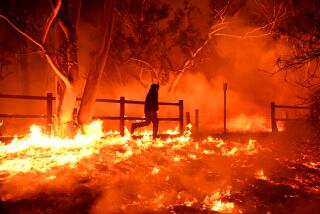Edison says dormant powerline is a leading theory for cause of Eaton fire

- Share via
- Edison will take steps to harden idle transmission towers and lines across its network to guard against possibile reenergizing events.
- Those measures include conducting additional field inspections, reviewing past inspections, and making changes in an internal maintenance manual.
- The investigation continues.
The possibility that an idle, unconnected Southern California Edison transmission line somehow reengerized on Jan. 7 is “a leading hypothesis” for what started the destructive Eaton fire, Edison International Chief Executive Pedro Pizarro said Friday.
In response, Edison will take steps to harden other idle towers and lines across its network to prevent reenergizing incidents. Those measures include conducting additional field inspections, reviewing past inspections, and making changes in an internal maintenance manual that instruct crews on how to properly ground the idle equipment.
In a Friday interview with The Times, Pizarro said the actions were being taken out of “an abundance of caution.” He also stressed that the company is still exploring all possibilities into what caused the fire. However, current evidence — including videos and data from the lines — suggests the possibility that the idle equipment was reenergized through a phenomenon called induction and sparked the Jan. 7 inferno.
“Induction seems to be a key thing to be looking at here because the idle line was not connected to any equipment,” Pizarro said. “It had no direct source of power. It was like an extension cord sitting on your floor, not connected to the wall.”
Southern California Edison changed how crews ground idle transmission towers just days after the Eaton fire, but they won’t say what was changed.
Induction occurs when the magnetic field of another active line nearby induces an electric current in the unconnected line. It is considered rare, but has been raised as a possibility by attorneys who have since sued Edison on behalf of residents who lost their homes in the fire.
Now, the utility is exploring it as a leading theory and also ensuring that similar idle equipment is properly grounded, so that sudden power surges can be safely dissipated into the earth.
“We have to look at everything,” Pizarro said. “Given that there was video of the flashing and the fire starting apparently around the idle transmission tower, and given that that line it was holding was not connected to anything, then induction becomes a leading hypothesis.”
Edison reported to the state’s regulatory commission that four of its lines over Eaton Canyon saw a momentary surge of electrical current at about the same time the fire ignited. In the filing, officials noted the current increase “remained within the design limits” of its circuits.
“Initially we didn’t think there were dots to connect here because we had protected equipment on all our transmission lines,” Pizarro said.
But video showing the initial flames of the fire appeared to be ignited under the idle tower raised serious concerns, and prompted the company to take additional steps.
As a precaution, Pizarro said, the giant utility company revised an internal manual that outlines how the idle equipment must be grounded.
At least one lawsuit filed against SCE included photos of the tower with four feet of exposed grounding wire protruding from the steep hillside.
The changes in the manual were noted in a filing with state regulators on Feb. 6. Edison had declined to provide the Los Angeles Times a copy of the changes or provide details on it for weeks, saying it was an internal document. The California Public Utilities Commission also denied a public records request from The Times to disclose the information.
On Friday, the company shared the revised section of the manual, which officials said provided uniformity into how idle Edison equipment is now to be grounded.
Southern California Edison has announced that it will bury more than 150 miles of power lines in in Altadena and Malibu following January’s firestorms.
Rajdeep Roy, vice president of transmission operations and substations for Edison, told The Times that the revision came after the Jan. 7 fires, and it was the only change made at the time.
Before the revision, grounding procedures were determined by engineers at the time that the equipment became idle, he said. The grounding procedures were based on a case-by-case basis due to the equipment, terrain and surrounding lines.
The new policies, reviewed by The Times on Friday, provide specifications for equipment, including the type of grounding wire to be used and number of bolts required depending on the type of structure. It also differentiates between the required grounding for wood, lightweight steel poles, and lattice towers like the ones under scrutiny in Eaton Canyon.
It also requires grounding every two miles of idle line, in sections that are within 600 feet of a 220kV or 500kV line.
“As you look across the industry, there isn’t a very clear common standard for what you do with an idle line,” Pizarro said.
Edison is reviewing whether the manual changes will require the company to install additional grounding of idle lines, or change grounding equipment, Pizarro said.
He also said crews were conducting field inspections of idle equipment, and performing “desktop inspections” — a review of photographs taken during past equipment visits to check for potentially overlooked issues.
“You have folks raising all types of theories from outside the company, and it just raises questions to say, ‘Let’s take another look,’” Pizarro said.
More to Read
Sign up for Essential California
The most important California stories and recommendations in your inbox every morning.
You may occasionally receive promotional content from the Los Angeles Times.












